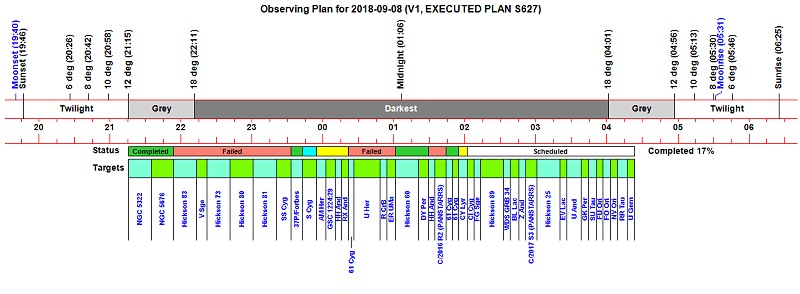David's Astronomy Pages
Notes - Session 627 (2018-09-08)
Notes
(S626)
Notes
Main
Home
Page
Notes
(S628)
David's Astronomy Pages
|
Notes (S626) |
Notes Main |
Home Page |
Notes (S628) |
Main aims
Equipment & Software
Highlights
Lowlights
Summary Plots & Logs
|
Observing Result (2018-09-08, S627) Operations started at 21:02, Sky Flats started at 19:58, Sky Flats ended at 20:50 Automated Mode from 20:53, Job Queue started at 21:13, Multiple Software & some hardware interruptions through period 22:00 to 01:38 Manual Mode from 02:05, Observatory Closed at 02:06 |
 |
| (Observation Status : Green=Completed, Yellow= Partially Completed, Red= Failed) |
|
Night Sky Summary Plot -
2018-09-08 Top axis: Sky Brightness at Zenith (in ADU/s) Lefthand axis: Local Time (hh LT). Righthand axis: Sun Altitude (degs) |
 |
Back to Top
Back to Top
The new Sky Flats routine was tested this evening. Eventually it will be kicked off by the Observatory Manager itself, but at this stage in its development it was manually initiated and monitoring.
Even though the routine was going to be kicked off manually the Observatory Manager operating in Manual Mode wouldn't allow the Dome Shutter to be opened as the Light Conditions were deemed to still be Critical. Observatory Manager service had to be turned
Routine was started off a bit too late (Sun Alt already at -2.4 deg) , so it was already a bit too dark for taking flats for Ha and B filter. Taking up to 10s for each frame (max allowed) everything was then delayed. It was also too dark for building up sufficient ADU within the 10s exposure, making the flat fairly useless anyway. The test was aborted after around 40 minutes with the Sun Altitude have reached -8.8 deg and the routine still on just set #5 out of 18.
Individual sets (a Filter/Bin combination with 15 frames) took up to 14
minutes to complete. With 2 minutes is taken up by slewing to the current
Zero Gradient Location and performing a couple of trial flats, it implied that
15 frames with 10s were taking some 12 minutes to acquire,. Allowing for 8s
download for 1x1 binned images these 15 frames might be expected to take only
4.5 minutes, the set contains a 7.5 minute overhead for dithering between frames
(5' jog for each frame )
The same 7.5 minute overhead would apply
if taking just 1s images at 3x3 binning (2s download). Without
dithering the set would take under 1 minute. During the time
taken to make a dither the sky is active darkening, requiring
additional extra exposure to take the frames, and delaying following sets.
Is dithering necessary? Well it's important to allow
Median Average processing to remove any stars that are present in the raw sky
flats. If any stars are present at fixed locations there signal will be
increased by either average or median average processing. When we dither a
given star will be at different positions on each frame and median average can
remove them.
Another possible approach is to turn off tracking during acquisition of a flat set, so any star signal is spread out across several pixels and the position will move from one frame to the next due to the sidereal movement of the stars vs. the stationary telescope. Any significant star signal can still be removed by median average processing. If necessary a short delay could be inserted between frames to ensure the airy disk of bright star in 1s frame, wouldn't overlap with the airy disk of the star in the next 1s frame. There will already be a binning dependent delay of between 2s and 8s between frames during which the frame is downloaded.
Because flat sets are being acquired more quickly without dithering, the sun will have descended less far there is less chance that star signal will show up against the sky signal.
So several useful lessons learnt from the test
a) start flats earlier
b)
allow a set to be aborted if the image ADU count can't be achieved ( ‘Target
ADU – tolerance’. )
c) be less ambitious over the number of filter/bin flat
sets that can be done within the same evening.
d) too much time is being
taken up in dithering between frames .
e) Observatory Manager to allow Dome
Shutter to be opened even when sky is still bright subject to operation being
conducted.
Back to Top
| This Web Page: | Notes - Session 627 (2018-09-08) |
| Last Updated : | 2023-11-26 |
| Site Owner : | David Richards |
| Home Page : | David's Astronomy Web Site |